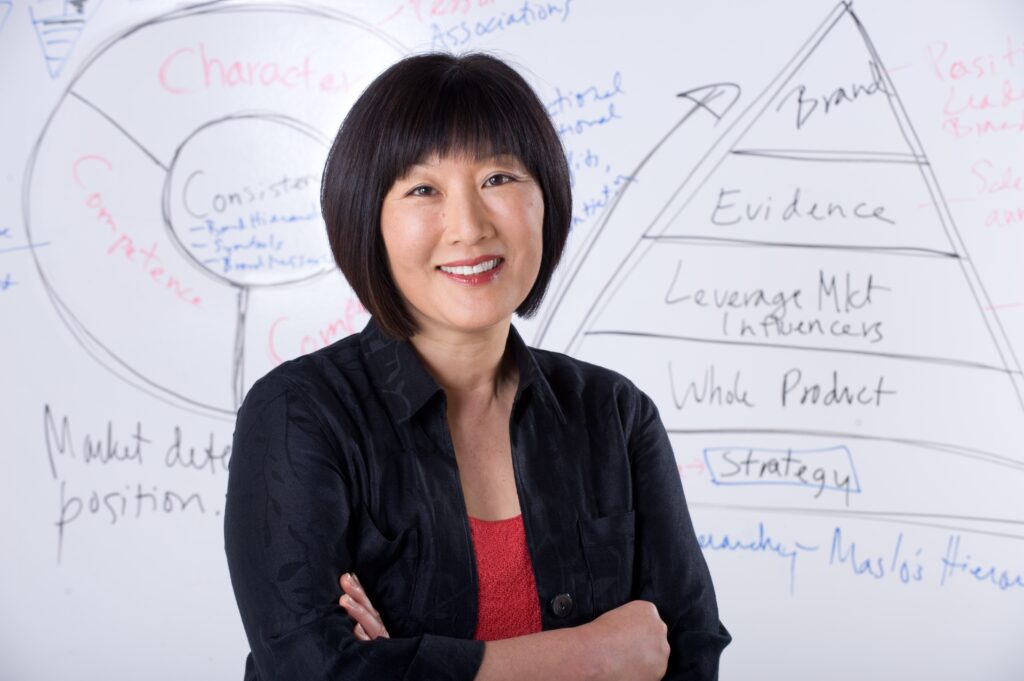Have you been passed over for a promotion? Again?
When others describe you do they use words like “visionary” or “dinosaur”?
Are you looking for a job?
How would you describe your own personal brand?
Have you missed an opportunity because someone thought of you incorrectly?
Take Charge of Your Personal Brand
Karen Kang is one of the world’s authorities on creating a personal brand. As a brand strategist, Karen guides individuals through a process to strategically create a personal brand. Karen knows what it takes to build a brand. She is a former partner with world-renowned Regis McKenna, Inc., the marketing firm that created and launched the Apple brand. She’s the founder and CEO of BrandingPays, and she has consulted with over 150 organizations around the world.
Her new book BrandingPays is a step-by-step guide to reinventing your personal brand. I recently had the opportunity to ask Karen a few questions about her work and her book.
Karen, you’ve worked with startups all the way to some of the world’s biggest companies. Although you continue to do corporate branding, your new work is mainly focused on individuals. Why is personal branding so important today? Has personal branding increased in importance?
Personal branding has gone from being a “nice to have” to a “got to do.” Competitive forces in business and communication—from globalization to social media—have combined to make personal branding a requirement. Gone are the days when you got on a career track with one company and rode it until the end of the line. Whether you work for a company or not, you are a free agent. You need to think like a “company of one” in how you position and market yourself.
The new model for work is collaborative and cross-functional teams. Even if you are known in one area, a new team may have never heard of you. That’s why it is imperative to empower your ecosystem to market you, and to be well positioned in LinkedIn and other social media that offer greater brand permanence, reach and engagement. The virtualization of work means we may never meet our collaborative team in person, so personal branding is key.
You start your book by busting three personal branding myths:
- Doing great work = a great reputation
- My boss will market my brand
- Self-promotion is boastful and bad
Without going into all of these, explain your observations on one and how many of us get it wrong.
Relying on your boss to market your brand is foolhardy in the new economy. No job, no boss or career ladder is secure. We must all think of ourselves as contractors, especially in the new collaborative work model. You need to be known for something of value for people to want to work with you. That means your job is to market and brand yourself. If you can’t be found, you’ll lose out on opportunities.
I love the picture you paint of the cake and the icing. So many people think branding is how you dress or how you talk. You say it goes much deeper. Tell us more.
In business, we often disparage “empty suits” as people who look good but have no content or value. I use the metaphor, “Bake the cake, then ice it” to help people understand that you need both cake and icing for a strong brand. Think of the cake foundation as your rational value or positioning and the icing as your emotional value, or how people connect with you emotionally such as personality, image or likability.
One engineer came up to me after one of my personal branding talks and said, “Now I get it. I’m all cake. I have no icing!” Believe me, she is not the only one. Often we spend so much time thinking about developing our hard skills and experience that we lose sight of the fact that the best brands attract you emotionally. Think of Starbucks, Disney and Coca-Cola. You need cake, but icing will make you more attractive and, should I say, “sticky”—that is, people will keep wanting to come back for more.
What’s the difference between bragging and branding?
Personal branding is not an exercise in narcissism. You need to shift your mindset from “me” to “we.” People will only be interested in your message if you are adding value to the world—and specifically, to them.
I like to think about personal branding in terms of education and engagement. When you post a profile on LinkedIn, the motivation should not be to brag about your accomplishments; it should be to paint a picture of how you can add value by solving a problem or enabling an important opportunity for a particular audience. If you position yourself in a compelling way, others will want to engage with you—offer you a job, make an introduction or partner with you.
There are five steps to creating a personal brand: positioning, messages, brand strategy, ecosystem, and action plan. The book takes you through each step and provides clear direction, so we won’t go into all of them. But, I do want to ask this: Is there one step that most of your clients get stuck on more than another?
Yes, I think positioning is the most difficult thing for people to do because it requires you to focus and not be all things to all people. It’s easy to write a laundry list, but it is hard to write a concise statement that positions you compellingly to a particular audience who has a problem you can solve. It requires a level of strategic thinking that most individuals never have applied to themselves or their careers.
Karen Kang's 5 Steps to Take Charge of Your Personal Brand
- Positioning
- Messages
- Brand Strategy
- Ecosystem
- Action Plan
Iterating the positioning statement until you get it right is critical because this is the cake foundation for your brand. It is true for companies, products and people. In marketing, you need to deliver something that a customer needs or wants. A good positioning statement will ensure that you are focused on serving a market need.
Would you share an example of someone who really had it all wrong and what happened when you helped create a personal brand?
I’d like to share an example of someone who had many fine brand attributes but didn’t package herself in a way to get the career opportunities she wanted. This person, whom I’ll call Pamela, had a good reputation as a marketing director but wanted to have a larger leadership role in an area of personal interest to her: patient access. She had to reinvent her brand to be seen as 1) an accomplished healthcare executive and 2) as a patient access expert and advocate. After completing all the foundational work in the 5-step BrandingPays System, she immediately took these key actions:
- Rewrote her LinkedIn profile, résumé and elevator pitch to match the new way she was positioning her value to the world. She pumped up past accomplishments and education in public health to be more credible in patient access.
- Upgraded her style, by trading in her casual image for a more executive look with a polished hairstyle, wardrobe and accessories.
- Corrected weaknesses in her ecosystem by developing and nurturing relationships beyond business at company social events.
- Spoke at company and industry events on patient access and new trends in healthcare to develop her vision branding platform.
- Met with her boss and key executives to educate them on her views for a consolidated approach to patient access, and later, her career goals.
- The upshot? She was recruited by other organizations but stayed at her current company because she was offered her dream job. Executive leadership created a new position in patient access for her by consolidating three separate business groups under her management. She headed a new group of 300 employees—a huge increase over her former staff of 40. Six months later, this Fortune 100 company promoted her to Senior Director.
Getting her dream job would not have happened had she not taken charge of her personal brand.
Why is having a personal tagline important and how can this be used to create a personal brand?
When I talk about a tagline in personal branding, it’s really a way to boil down your message into a few words. People will only remember one or two things about you. So a “tagline” is essential to be remembered and promoted by your ecosystem.
Pamela’s tagline became “Healthcare Executive and Patient Access Expert.” Her old tagline, “Marketing Director, XYZ Corporation,” did nothing to differentiate her and did not position her well for executive opportunities in patient access.
I have many consultant friends I’d like to help, but they have no clear positioning focus, and it is difficult for me to remember what opportunities may be best suited for their talents and interests. Make it easy for people to help you by developing a personal branding tagline. BrandingPays is my company name, my book title and my value proposition. Branding is my expertise and business, and few who meet me or hear about me forget this.
I’m a big fan of Geoffrey Moore’s work and interviewed him previously. I noticed that he wrote your forward, and I know you have breakfast with him regularly. How has he influenced you over the years?
First of all, Geoffrey and I are friends, having worked together as principals and partners with Regis McKenna, who greatly shaped our ideas about marketing and competitive positioning. Geoff and I probably only get together twice a year because of our busy schedules, but each time we meet I am inspired by his new ideas or his encouragement of my own. As a business entrepreneur, thought leader and author, Geoff is my role model. He told me that during a formative period in his business career, a boss asked him why he was afraid of being powerful. It shook him up and he has embraced his power every since. It’s a lesson that resonates with me. Who hasn’t been afraid to speak up or lead for fear of failure? Despite his fame and accolades, Geoff has a self-deprecating sense of humor that keeps him grounded and accessible. I hold dear all of his lessons—both business and personal.


